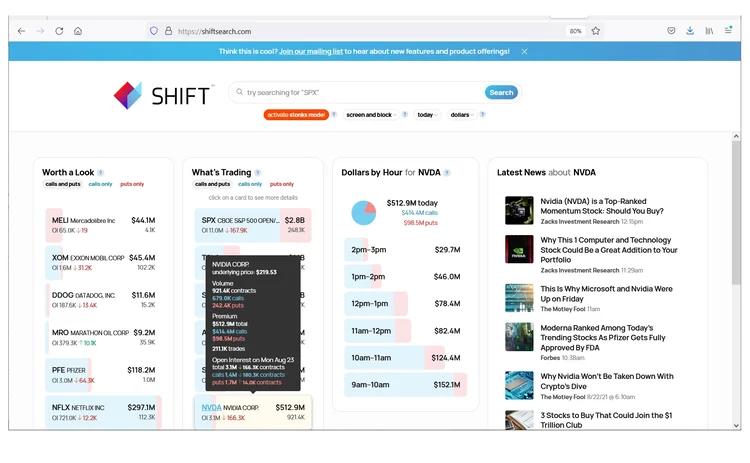Miax preps ‘Virtual Trading Floor’ of data tools to grow investors, market-makers
The options exchange operator hopes to make it easier for participants to translate data into context and insight, and to broaden participation from new market sectors.

The Miami International Securities Exchange (Miax) is assembling a collection of third-party data, tools and services that will provide insight to market participants trading options on its platform, and to market-makers and broker-dealers providing liquidity on the exchange.
The development of Miax’s concept of a Virtual Trading Floor (VTF)—which would provide data and tools to boost investor and institutional participation and support an electronic broker-based request-for-quote (RFQ) “call-around” process—has been underway for several years. The project has been led by John Smollen, an options industry veteran who is executive vice president and head of exchange-traded products and strategic relations at the exchange’s parent group Miami International Holdings. Now, the exchange aims to have a fully developed version of VTF ready next year.
“It’s about getting more people involved in trading, and attracting more [market-makers] to respond to RFQs. It’s well documented that having more people involved in a market and more liquidity—whether retail or institutional—makes that market more transparent, more competitive, and a better ecosystem,” he says.
Smollen says he first envisaged the idea of a Virtual Trading Floor while serving as a managing director at Goldman Sachs. He brought the idea with him when he joined Miax in 2014, initially as a strategic consultant. Since coming up with the original version in 2015, the exchange has been building pieces of VTF into its business, assembling a collection of data and tools to support multiple categories of services, including options pricing and risk management.
Then Smollen met Saad Hussain, founder and CEO of California-based startup Vesica Technologies.
Vesica provides a tool called Shift Search, currently available for free to anyone on its website, which displays open interest and volume data, broken down by put and call options activity, along with relevant news. Users can get an at-a-glance overview of key market activity on its homepage, or search for specific options.

Hussain says he got the idea after working as an oil options broker for almost a decade at PVM Oil Associates (now owned by TP Icap). “Clients would always call up and ask, ‘What’s happening? What’s going on in the market?’ and I would think, ‘You have a Bloomberg. Why are you asking me?’ Then I understood that people want context, not just a data point. You have to tell people a story. The challenge is, how do you allow people to see that story without being too complex about it?”
The headline put and call information provides a snapshot in time of options activity, but Shift Search also allows users to look at historical put and call activity. “So, for example, if you see a bunch of call option buying, you can see that ‘story’ being formed,” Hussain says. “How open interest, volatility, and money flows behave all tell a story.”
After first meeting with Vesica, Smollen says he flipped the concept of the Virtual Trading Floor to primarily target retail investors, rather than institutional clients. His thinking was to do exactly what fintech app developers are increasingly doing: Why chase five funds for $1 million each when you can sell to 5 million retail investors for $1 apiece? He calls it the Robinhood model—which itself flipped its focus to retail investors after its first incarnation as Chronos Research, a high-performance ticker plant software vendor targeting high-frequency traders.
Miax was so convinced of Vesica’s potential that the exchange bought an undisclosed equity stake in the startup in late 2020. Since making Shift Search available on its website earlier this year, Miax has recorded around 125,000 users accessing the tool. These numbers don’t automatically translate to revenues, since Miax makes the tool available free of charge, but Smollen says it has other benefits.
“If I can create tools that make people better at trading, that’s good for our business, and that helps the Miax brand,” he says.
In addition, that data also has value to institutional investors and market makers. While the primary focus of Shift Search and Miax’s other plans revolve around supporting retail investors, the flip side is that the aggregate of what investors are researching could prove appealing to institutional participants, and reveal where investors are targeting their activity, helping market makers to be more targeted in their quoting, and potentially attracting new classes of institutional participants that Smollen believes will be key sources of liquidity in the future.
“Market makers may want to see what’s being researched so they can be more aggressive around those strikes,” he says. “Maybe we won’t get thousands of market makers … but with the evolving changes in technology, I think liquidity will come from new players—yes, from big traditional market makers, but also from other types of firms figuring out how they can be more active, and specifically, how they can provide targeted liquidity around specific strike prices.”
Smollen also made Shift Search the keystone of Miax’s Virtual Trading Floor plans, believing that—especially when augmented with other datasets and additional context—it could provide the most insight to investors at a glance.
“Shift Search puts everything you need to know for research and for generating ideas at your fingertips,” he says. “What we want to create with Shift and others is something that will allow people to come to Miax and very quickly get an idea of what’s going on in the market.”
Though Smollen believes the majority of users so far are from Miax’s core base of retail investors, he says users run the gamut from heads of prop trading desks to college students—and that places a responsibility on the exchange to provide tools and data that help investors make better-informed decisions.
“Trading apps like Robinhood, eToro and Webull have brought 60 million new investors to the market. But no one is giving those investors a way to understand the markets,” he says.
Or, as Hussain puts it, “Democratization isn’t just about giving investors access to trading—that’s like taking people to Las Vegas and just throwing money on the table. Democratization is about data.”
Further reading
Only users who have a paid subscription or are part of a corporate subscription are able to print or copy content.
To access these options, along with all other subscription benefits, please contact info@waterstechnology.com or view our subscription options here: http://subscriptions.waterstechnology.com/subscribe
You are currently unable to print this content. Please contact info@waterstechnology.com to find out more.
You are currently unable to copy this content. Please contact info@waterstechnology.com to find out more.
Copyright Infopro Digital Limited. All rights reserved.
As outlined in our terms and conditions, https://www.infopro-digital.com/terms-and-conditions/subscriptions/ (point 2.4), printing is limited to a single copy.
If you would like to purchase additional rights please email info@waterstechnology.com
Copyright Infopro Digital Limited. All rights reserved.
You may share this content using our article tools. As outlined in our terms and conditions, https://www.infopro-digital.com/terms-and-conditions/subscriptions/ (clause 2.4), an Authorised User may only make one copy of the materials for their own personal use. You must also comply with the restrictions in clause 2.5.
If you would like to purchase additional rights please email info@waterstechnology.com
More on Data Management
New working group to create open framework for managing rising market data costs
Substantive Research is putting together a working group of market data-consuming firms with the aim of crafting quantitative metrics for market data cost avoidance.
Off-channel messaging (and regulators) still a massive headache for banks
Waters Wrap: Anthony wonders why US regulators are waging a war using fines, while European regulators have chosen a less draconian path.
Back to basics: Data management woes continue for the buy side
Data management platform Fencore helps investment managers resolve symptoms of not having a central data layer.
‘Feature, not a bug’: Bloomberg makes the case for Figi
Bloomberg created the Figi identifier, but ceded all its rights to the Object Management Group 10 years ago. Here, Bloomberg’s Richard Robinson and Steve Meizanis write to dispel what they believe to be misconceptions about Figi and the FDTA.
SS&C builds data mesh to unite acquired platforms
The vendor is using GenAI and APIs as part of the ongoing project.
Aussie asset managers struggle to meet ‘bank-like’ collateral, margin obligations
New margin and collateral requirements imposed by UMR and its regulator, Apra, are forcing buy-side firms to find tools to help.
Where have all the exchange platform providers gone?
The IMD Wrap: Running an exchange is a profitable business. The margins on market data sales alone can be staggering. And since every exchange needs a reliable and efficient exchange technology stack, Max asks why more vendors aren’t diving into this space.
Reading the bones: Citi, BNY, Morgan Stanley invest in AI, alt data, & private markets
Investment arms at large US banks are taken with emerging technologies such as generative AI, alternative and unstructured data, and private markets as they look to partner with, acquire, and invest in leading startups.








